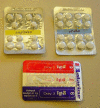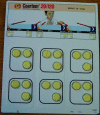Unit-dose packaged drugs for treating malaria
- PMID: 15846723
- PMCID: PMC6532754
- DOI: 10.1002/14651858.CD004614.pub2
Unit-dose packaged drugs for treating malaria
Abstract
Background: Unit-dose packaging of antimalarial drugs may improve malaria cure by making it easier for patients to take their treatment correctly.
Objectives: To summarize the effects of unit-dose packaged treatment on cure and treatment adherence in people with uncomplicated malaria.
Search strategy: We searched the Cochrane Infectious Diseases Group Specialized Register (November 2004), CENTRAL (The Cochrane Library Issue 4, 2004), MEDLINE (1966 to November 2004), EMBASE (1980 to November 2004), LILACS (November 2004), conference proceedings, and reference lists of articles. We also contacted pharmaceutical companies, organizations, and researchers in the field.
Selection criteria: Randomized controlled trials (RCTs), cluster-RCTs, quasi-RCTs, and controlled before-and-after studies of unit-dose packaged drugs for treating uncomplicated malaria.
Data collection and analysis: We independently assessed study eligibility and methodological quality, and extracted data for an intention to treat analysis, where possible. We combined binary data using relative risk (RR) and the fixed-effect model, and presented them with 95% confidence intervals (CI). We attempted to contact study authors for additional information.
Main results: Three quasi-RCTs (895 participants) and one cluster-RCT (6 health facilities) met the inclusion criteria. Trials were of poor methodological quality, and none adequately assessed treatment failure. Unit-dose packaged drugs (in conjunction with prescriber training and patient information) appeared to be associated with higher participant-reported treatment adherence in all trials.A meta-analysis of two trials (596 participants) showed that participant-reported treatment adherence was higher with blister-packed tablets compared with tablets in paper envelopes (RR 1.18, 1.12 to 1.25). Two trials using tablets in sectioned polythene bags as the intervention also noted an increase in participant-reported treatment adherence: the cluster-RCT (6 clusters) compared it with tablets in paper envelopes, and the other trial compared it with syrup in bottles (RR 2.15, 1.76 to 2.61; 299 participants).
Authors' conclusions: There is insufficient evidence to determine the effect of unit-dose packaged antimalarial drugs on treatment failure. Unit-dose packaging supported by prescriber training and patient information appears to improve participant-reported treatment adherence, but these data come from trials with methodological limitations.
Conflict of interest statement
Guy Barnish was involved in one of the included trials, however he knows of no conflicts of interest. Lois Orton has no known conflicts of interest.
Figures







Update of
References
References to studies included in this review
Ansah 2003 {published data only}
-
- Ansah EK, Gyapong JO, Agyepong IA, Evans DB. Improving adherence to malaria treatment for children: the use of pre‐packed chloroquine tablets vs. chloroquine syrup. Tropical Medicine and International Health 2003;6(7):496‐504. - PubMed
Lauwo 2006 {published and unpublished data}
-
- Lauwo JAK, Hombhanje FW, Tulo SP, Maibani G, Bjorge S. Impact of pre‐packaging antimalarial drugs and counselling on compliance with malaria treatment at Port Moresby General Hospital Adult Outpatient Department. Papua New Guinea Medical Journal 2006;49:14‐21. - PubMed
Li 1998a {published and unpublished data}
Li 1998b {published and unpublished data}
References to studies excluded from this review
Agyepong 2002 {published data only}
-
- Agyepong IA, Ansah E, Gyapong M, Adjei S, Barnish G, Evans D. Strategies to improve adherence to recommended chloroquine treatment regimes: a quasi‐experiment in the context of integrated primary health care delivery in Ghana. Social Science & Medicine 2002;55:2215‐26. - PubMed
Browne 2001 {unpublished data only}
-
- Browne ENL, Hall‐Baidu D, Sangber‐Dery F, Owusu‐Antwi F. Early appropriate management of fevers in children aged 6 months to 6 years in Ghana [unpublished]. World Health Organization TDR PROJECT No. 990614 2001.
Cullinan 1997 {published data only}
Krudsood 2002 {published data only}
-
- Krudsood S, Looareesuwan S, Silachamroon U, Chalermrut K, Pittrow D, Canbon N, et al. Artesunate and mefloquine given simultaneously for three days via a prepacked blister is equally effective and tolerated as a standard sequential treatment of uncomplicated acute Plasmodium falciparum malaria: randomized, double‐blind study in Thailand. American Journal of Tropical Medicine and Hygiene 2002;67(5):465‐72. - PubMed
Okonkwo 2001 {published data only}
-
- Okonkwo PO, Akpala CO, Okafor HU, Mbah AU, Nwaiwu O. Compliance to correct dose of chloroquine in uncomplicated malaria correlates with improvement in the condition of rural Nigerian children. Transactions of the Royal Society of Tropical Medicine and Hygiene 2001;95(3):320‐4. - PubMed
Pagnoni 1997 {published data only}
-
- Pagnoni F, Convelbo N, Tiendrebeogo J, Cousens S, Esposito F. A community‐based programme to provide prompt and adequate treatment of presumptive malaria in children. Transactions of the Royal Society of Tropical Medicine and Hygiene 1997;91(5):512‐7. - PubMed
Shwe 1998 {published data only}
Sirima 2003 {published data only}
-
- Sirima SB, Konate A, Tiono AB, Convelbo N, Cousens S, Pagnoni F. Early treatment of childhood fevers with pre‐packaged antimalarial drugs in the home reduces severe malaria morbidity in Burkina Faso. Tropical Medicine and International Health 2003;8(2):133‐9. - PubMed
Additional references
Alderson 2004
-
- Alderson P, Green S, Higgins J, editors. Highly sensitive search strategy for identifying reports of randomized controlled trials in MEDLINE. Cochrane Reviewers' Handbook 4.2.2 [Updated March 2004]; Appendix 5b. http://www.cochrane.org/resources/handbook/hbook.htm (accessed 25 January 2005).
Becker 1986
-
- Becker LA, Glanz K, Sobel E, Mossey J, Zinn SL, Knott KA. A randomized trial of special packaging of antihypertensive medications. Journal of Family Practice 1986;22(4):357‐61. - PubMed
Biritwum 2000
-
- Biritwum RB, Welbeck J, Barnish G. Incidence and management of malaria in two communities of different socio‐economic level, in Accra, Ghana. Annals of Tropical Medicine and Parasitology 2000;94(8):771‐8. - PubMed
Bloland 2003
-
- Bloland PB, Kachur SP, Williams HA. Trends in antimalarial drug deployment in sub‐Saharan Africa. The Journal of Experimental Biology 2003;206(21):3761‐9. - PubMed
Francis 1997
-
- Francis F. The packaging of anti‐malarials in Africa: communication issues [oral presentation]. The Tropical Diseases and Health Sector Reform Task Force Meeting, 10‐12 September 1997, Liverpool.
Gomes 1998
Haynes 1996
-
- Haynes RB, McKibbon KA, Kanani R. Systematic review of randomised trials of interventions to assist patients to follow prescriptions for medications. Lancet 1996;348(9024):383‐6. - PubMed
Haynes 2008
-
- Haynes RB, Ackloo E, Sahota N, McDonald HP, Yao X. Interventions for enhancing medication adherence. Cochrane Database of Systematic Reviews 2008, Issue 2. [Art. No.: CD000011. DOI: 10.1002/14651858.CD000011.pub3] - PubMed
Heneghan 2006
Henry 1999
-
- Henry A, Batey RG. Enhancing compliance not a prerequisite for effective eradication of Helicobacter pylori: the HelP Study. The American Journal of Gastroenterology 1999;94(3):811‐5. - PubMed
Higgins 2008
-
- Higgins JPT, Green S (editors). Cochrane Handbook for Systematic Reviews of Interventions Version 5.0.1. [Updated September 2008]. The Cochrane Collaboration, 2008.
Juni 2001
Kilian 2003
-
- Kilian AHD, Tindyebwa D, Gulck T, Byamukama W, Rubaale T, Kabagambe G, et al. Attitude of women in western Uganda towards pre‐packed, unit‐dosed malaria treatment for children. Tropical Medicine and International Health 2003;8(5):431‐8. - PubMed
Marsh 2004
-
- Marsh VM, Mutemi WM, Willetts A, Bayah K, Were S, Ross A, et al. Improving malaria home treatment by training drug retailers in rural Kenya. Tropical Medicine and International Health 2004;9(4):451‐60. - PubMed
Ondari 2003
-
- Ondari C. Personal communication 20 March 2003.
Peterson 1984
-
- Peterson GM, McLean S, Millingen KS. A randomised trial of strategies to improve patient compliance with anticonvulsant therapy. Epilepsia 1984;25(4):412‐7. - PubMed
RevMan 2008 [Computer program]
-
- The Nordic Cochrane Centre. The Cochrane Collaboration. Review Manager (RevMan). Version 5.0. Copenhagen: The Nordic Cochrane Centre. The Cochrane Collaboration, 2008.
Richardson 2003
-
- Richardson, Edwards. Inc. A brief history of packaging. www.richanded.com/html/packaging_history.htm (accessed 18 September 2003).
Sackett 1979
-
- Sackett DL, Snow JC. The magnitude of adherence and nonadherence. In: Haynes RB, Taylor DW, Sackett DL editor(s). Compliance in health care. Baltimore: John Hopkins University Press, 1979:11‐22.
Standing 2004
-
- Standing JF, Wong ICK. Chlorproguanil‐dapsone for malaria. Lancet 2004;364(9447):1752‐3. - PubMed
Sumartojo 1993
-
- Sumartojo E. When tuberculosis treatment fails. A social behavioural account of patient adherence. American Review of Respiratory Diseases 1993;147(5):1311‐20. - PubMed
Volmink 1997
White 1998
-
- White NJ. Why is it that antimalarial drug treatments do not always work?. Annals of Tropical Medicine and Parasitology 1998;92(4):449‐58. - PubMed
White 1999
-
- White NJ, Nosten F, Looareesuwan S, Watkins WM, Marsh K, Snow RW, et al. Averting a malaria disaster. Lancet 1999;353(9168):1965‐7. - PubMed
WHO 1993
-
- World Health Organization. A global strategy for malaria for malaria control. Geneva: World Health Organization, 1993.
WHO 2000
-
- World Health Organization, Gilles HM. Management of severe malaria: a practical handbook. 2nd Edition. World Health Organization: Geneva, 2000.
WHO 2003
-
- Malaria Control Department, World Health Organization. An update on quality assurance and procurement through WHO for improving access to artemisinin‐based combination treatments (ACTs) for malaria. http://www.paho.org/English/AD/DPC/CD/mal‐acts‐update‐7‐03.pdf 2003 (accessed 11 November 2003).
WHO 2004
-
- World Health Organization. The world health report 2004: changing history. World Health Organization: Geneva, 2004.
WHO 2006
-
- World Health Organization. Guidelines for the treatment of malaria 2006.
Publication types
MeSH terms
Substances
LinkOut - more resources
Full Text Sources
Medical
Miscellaneous

